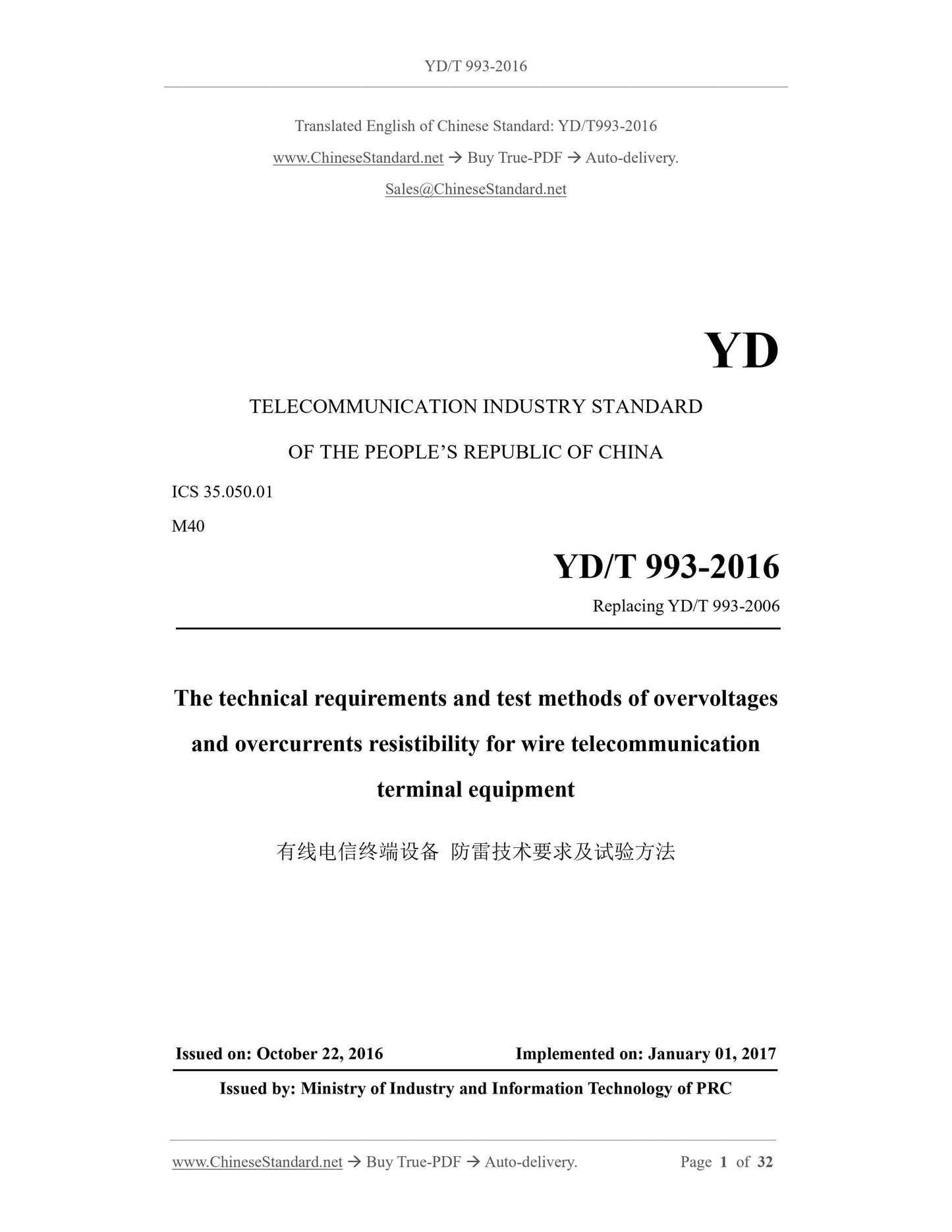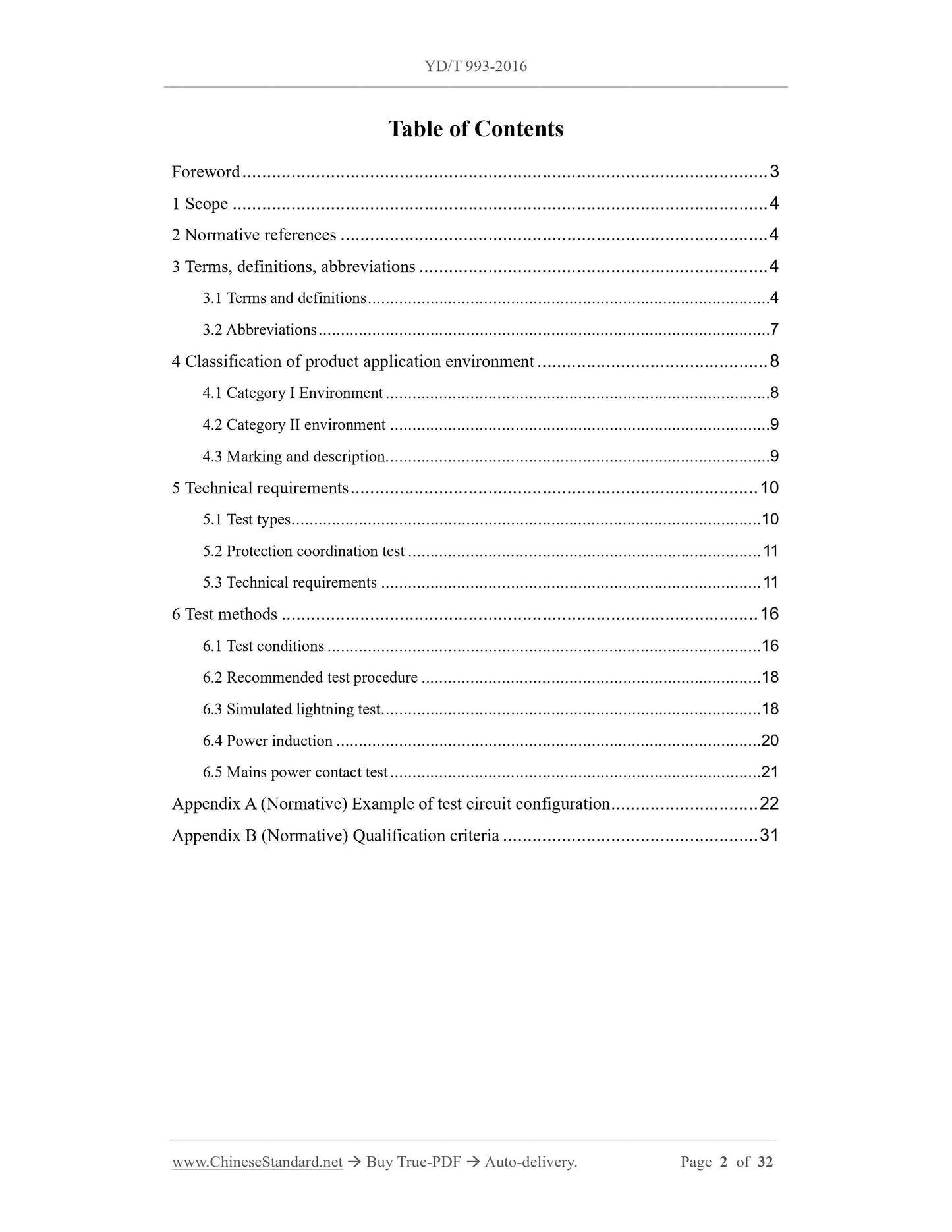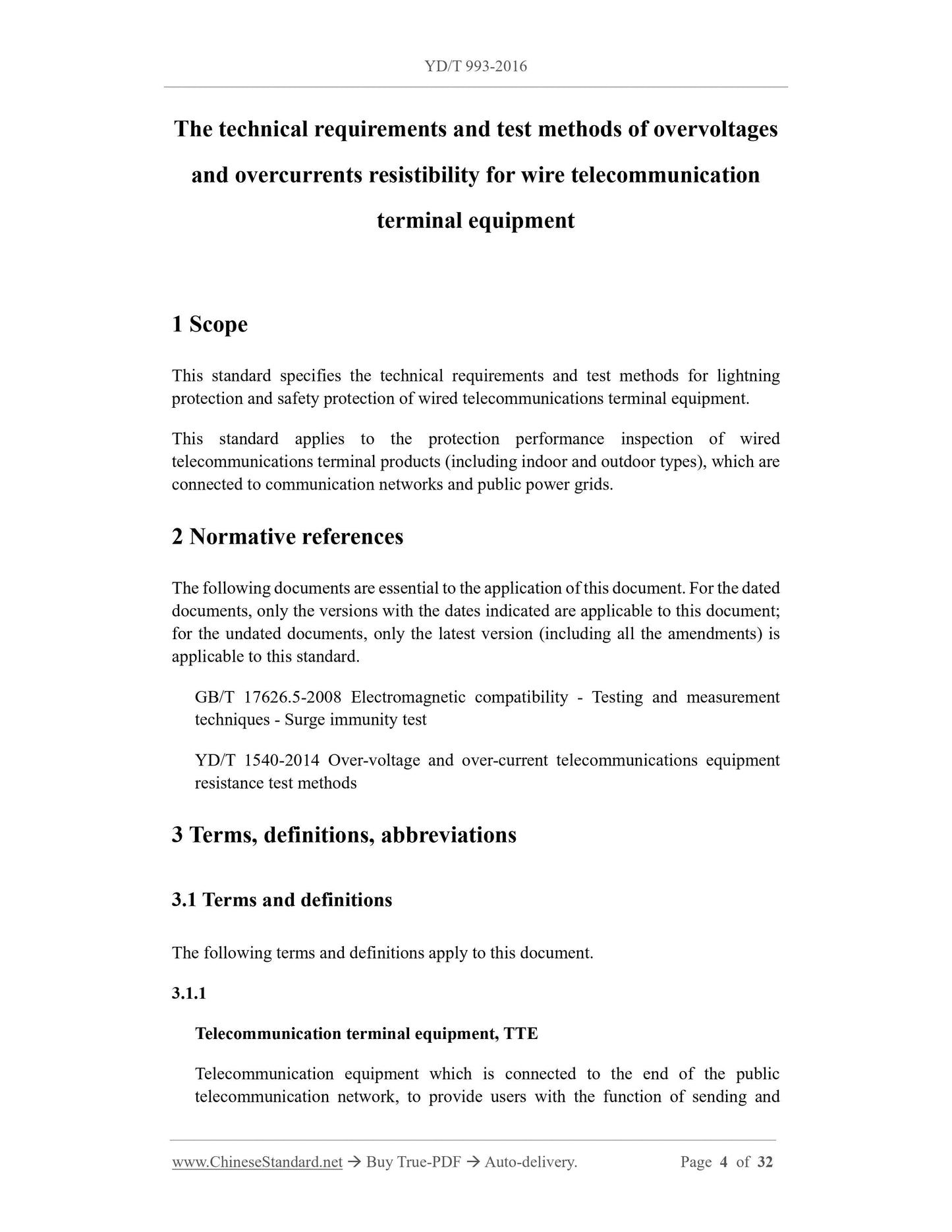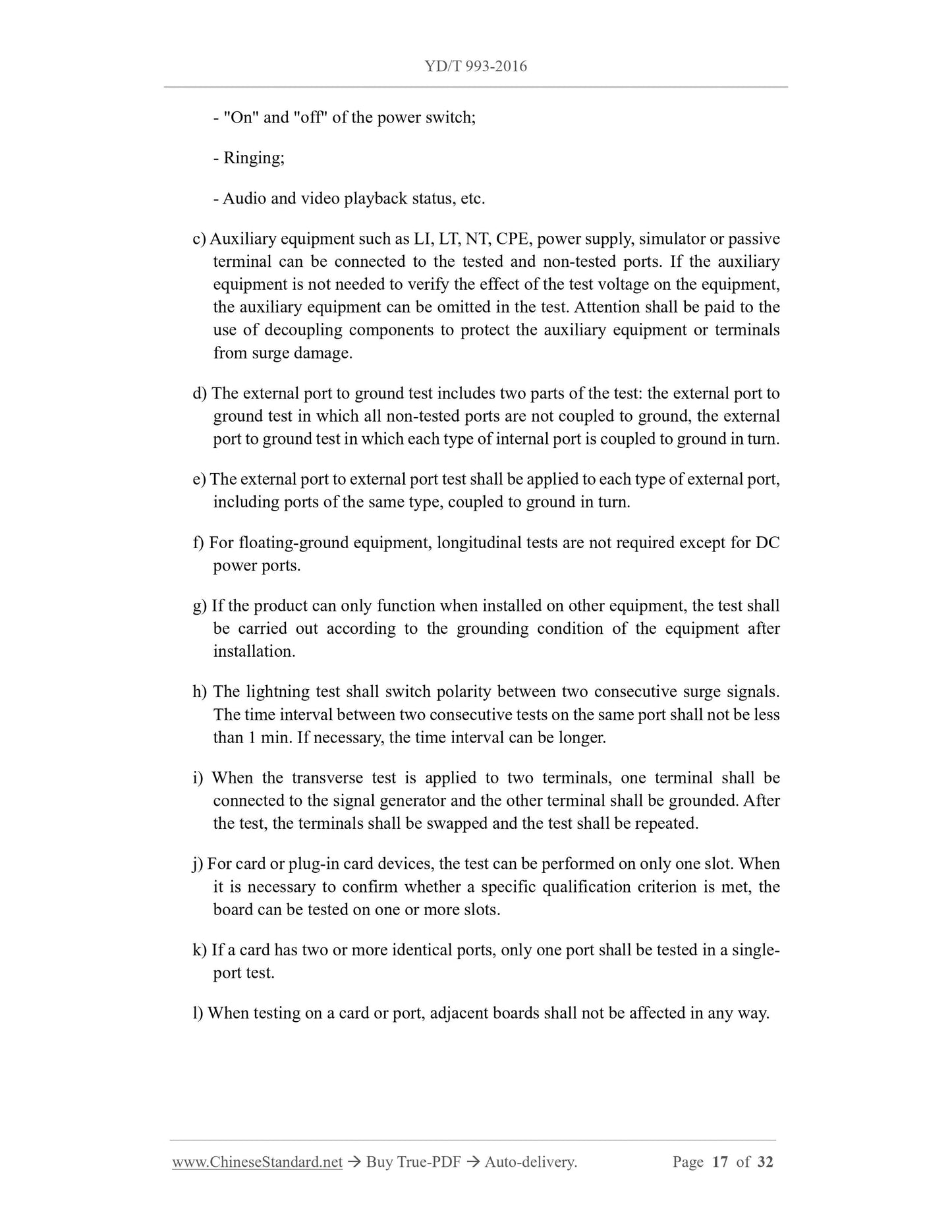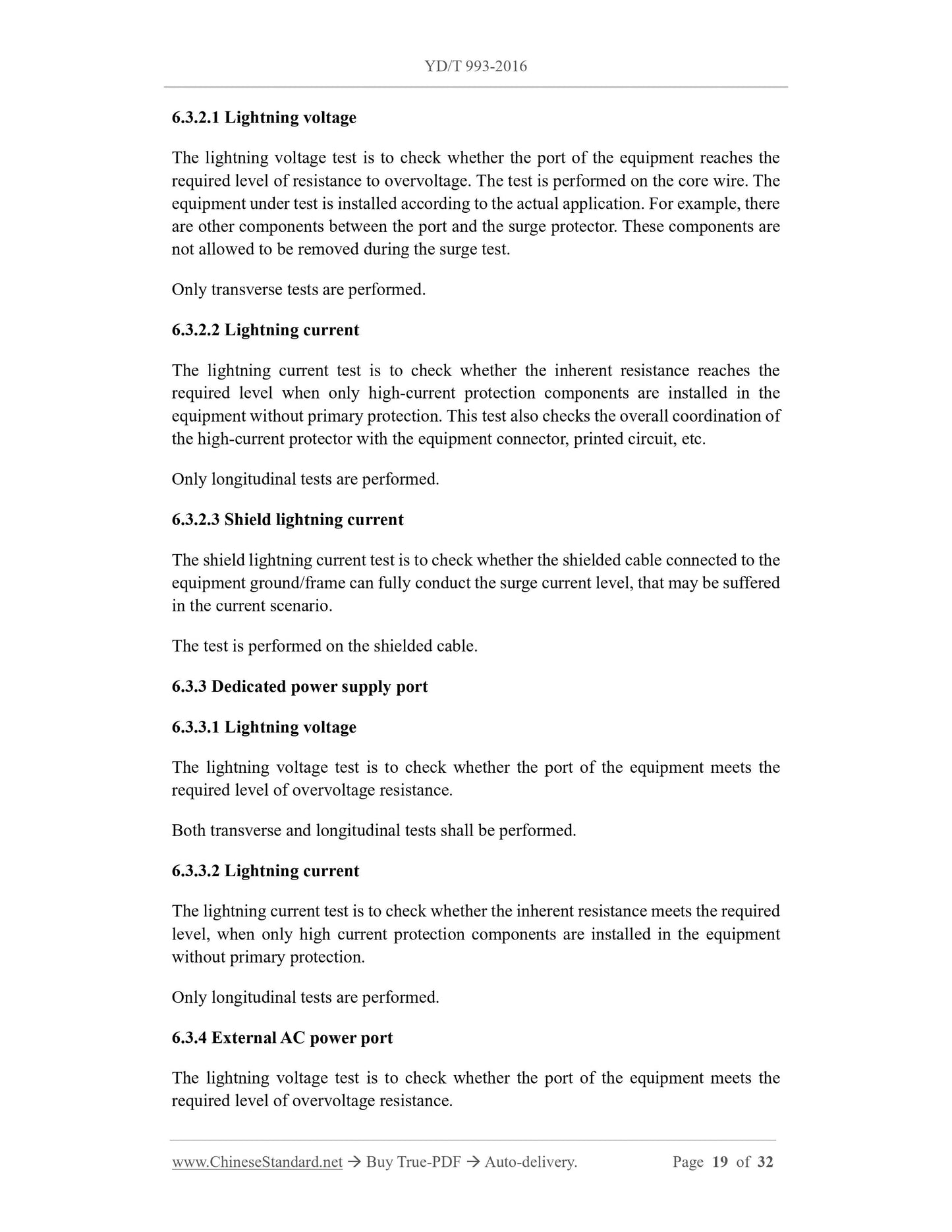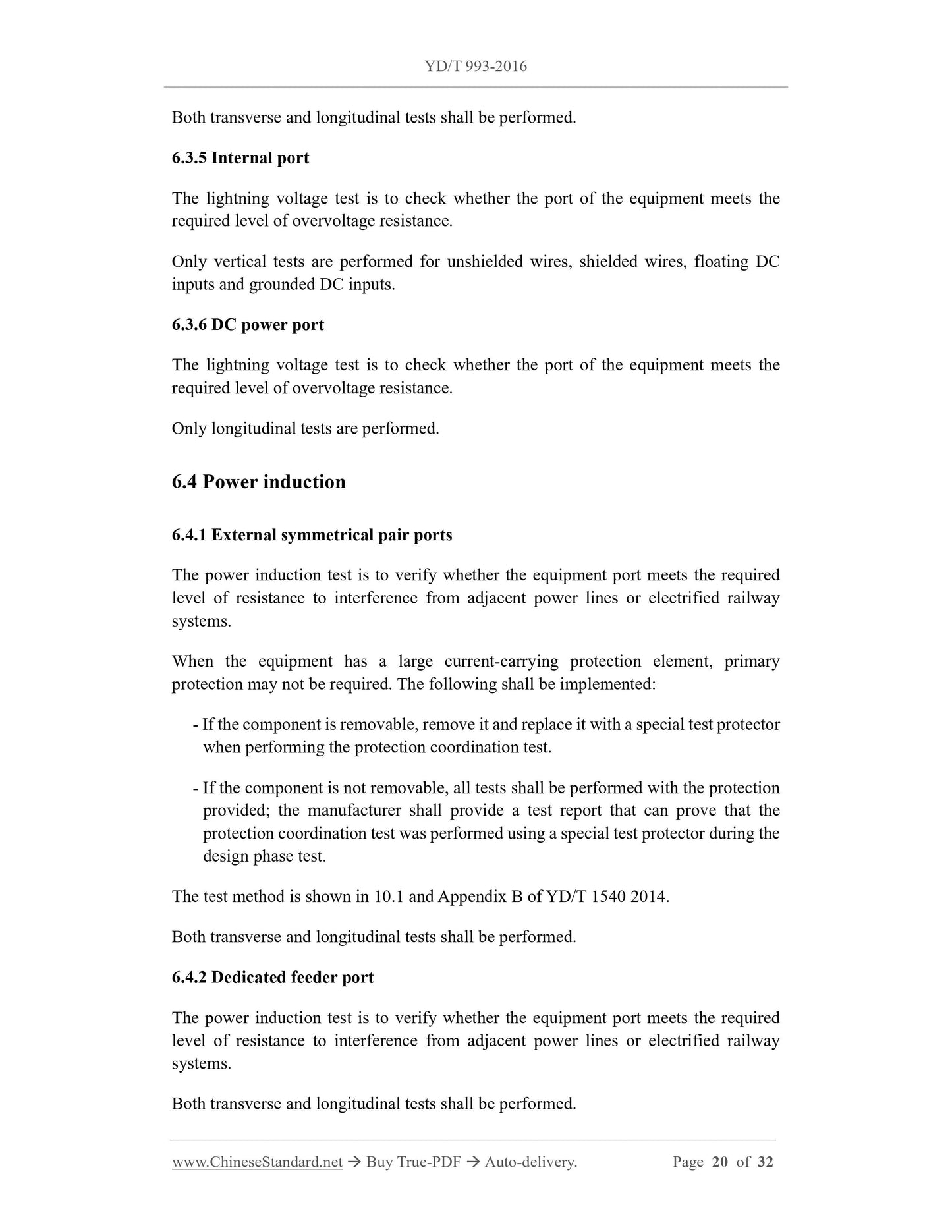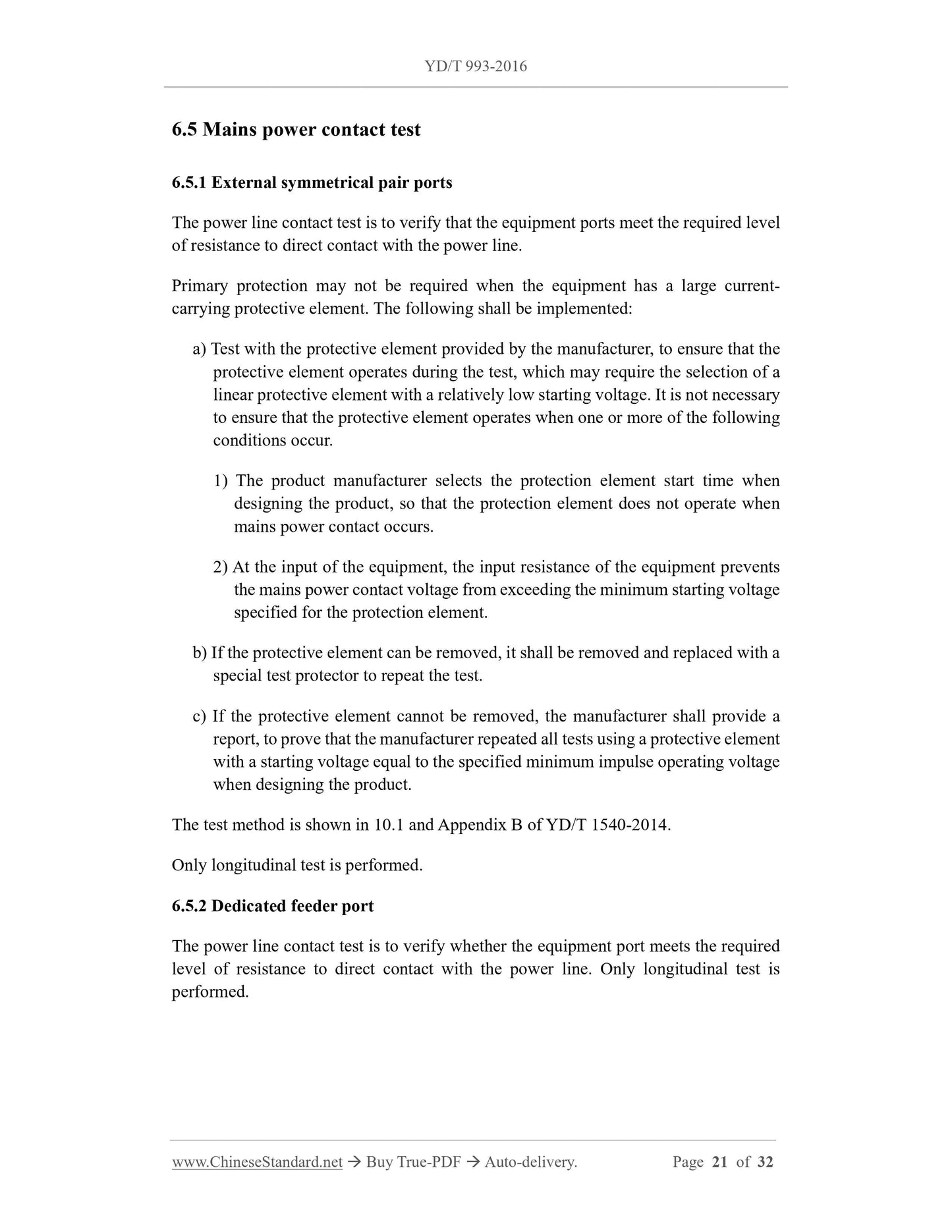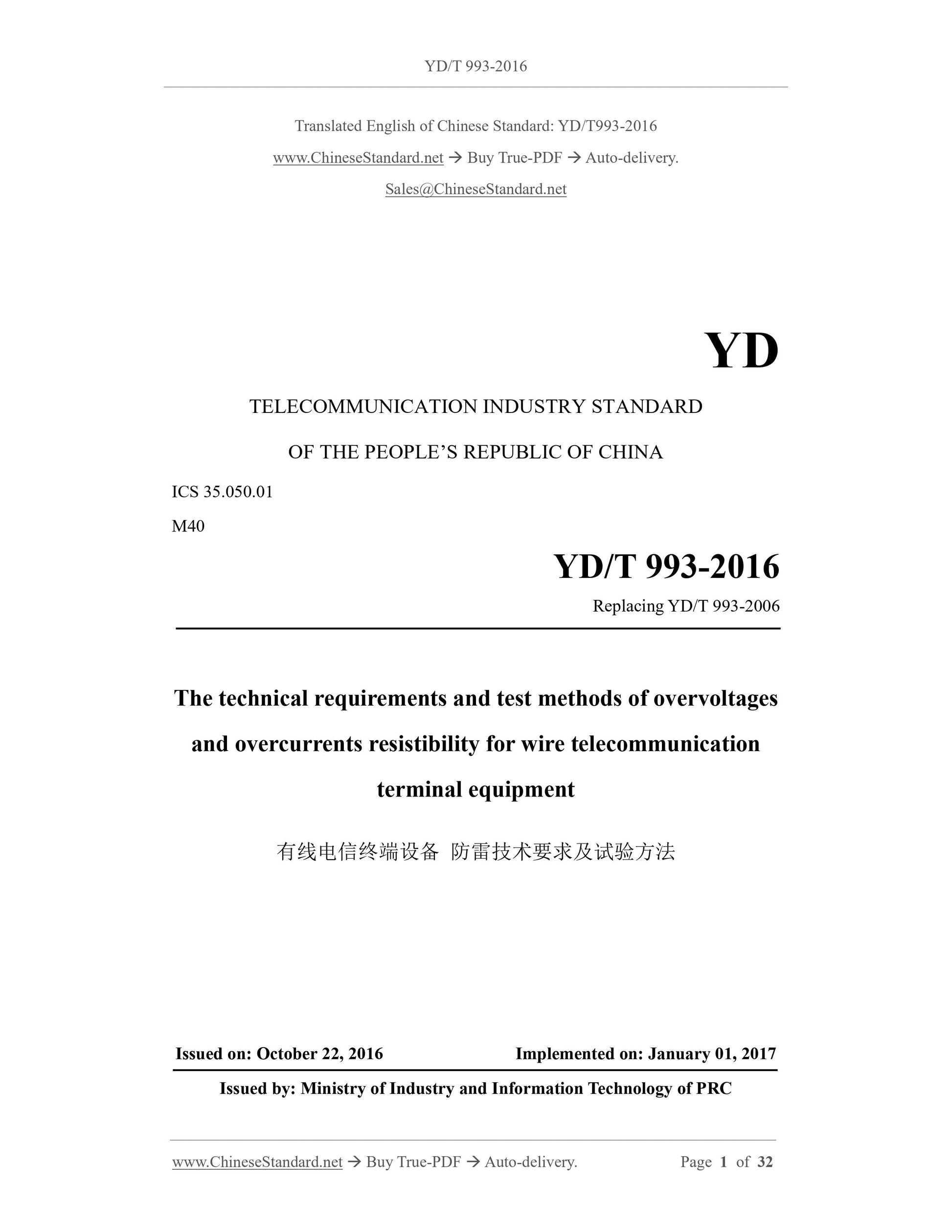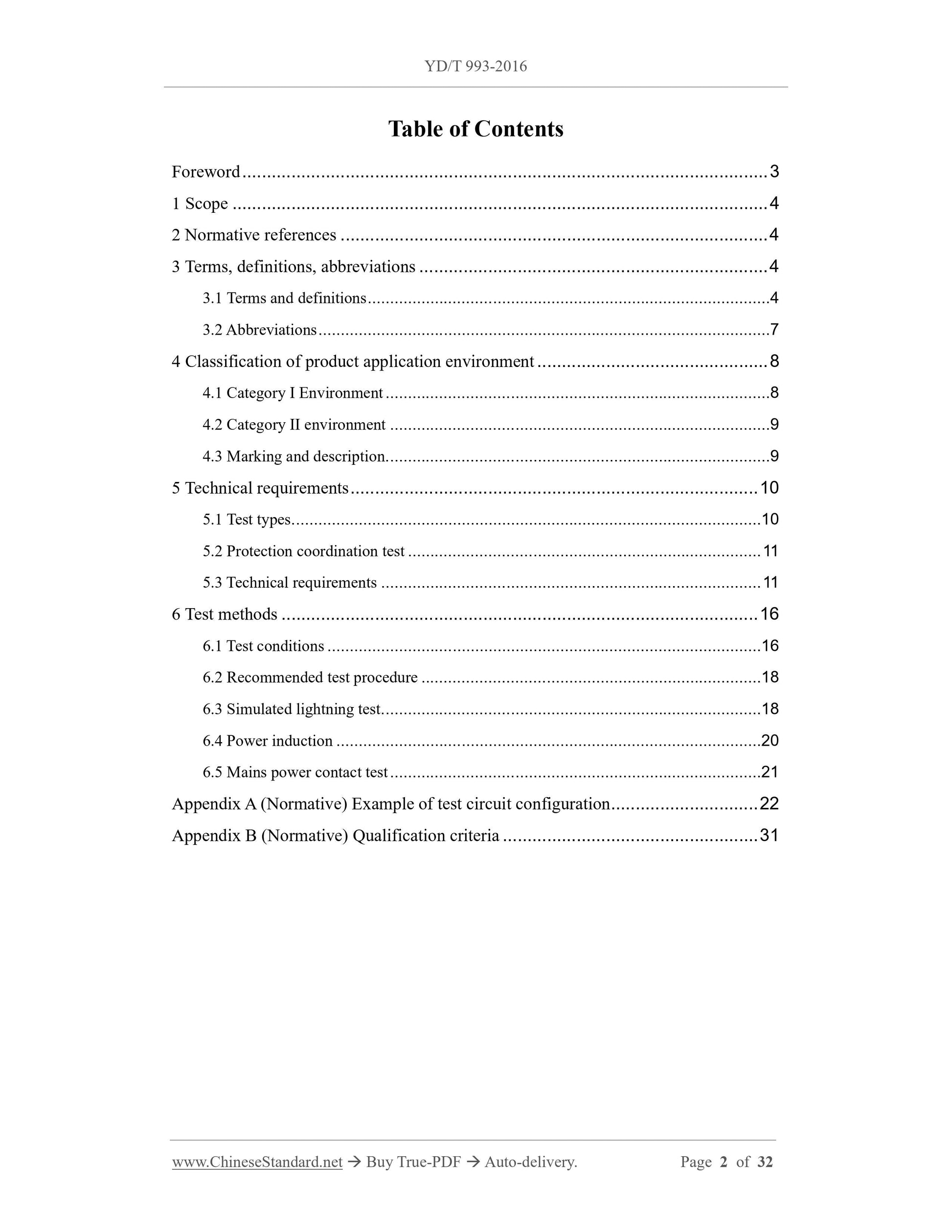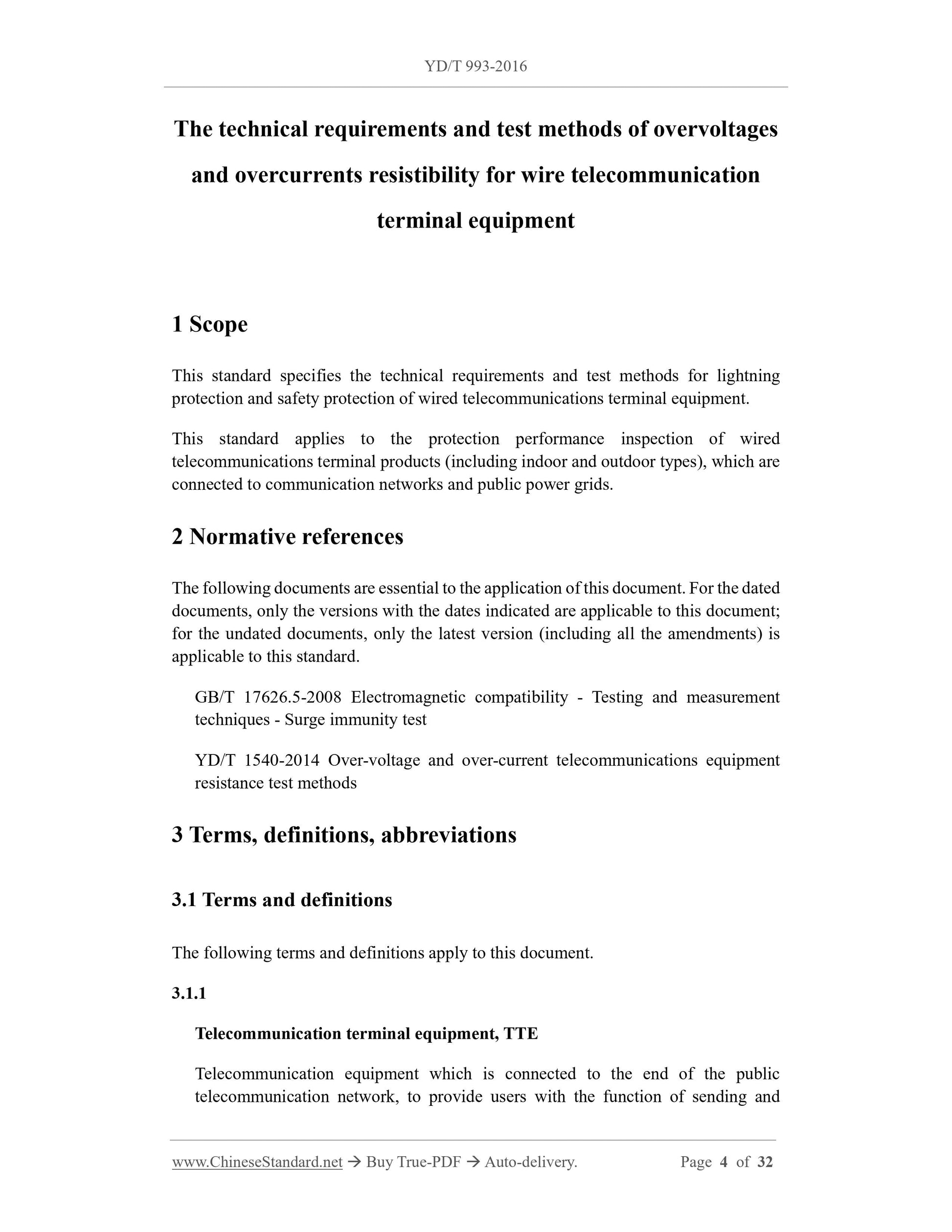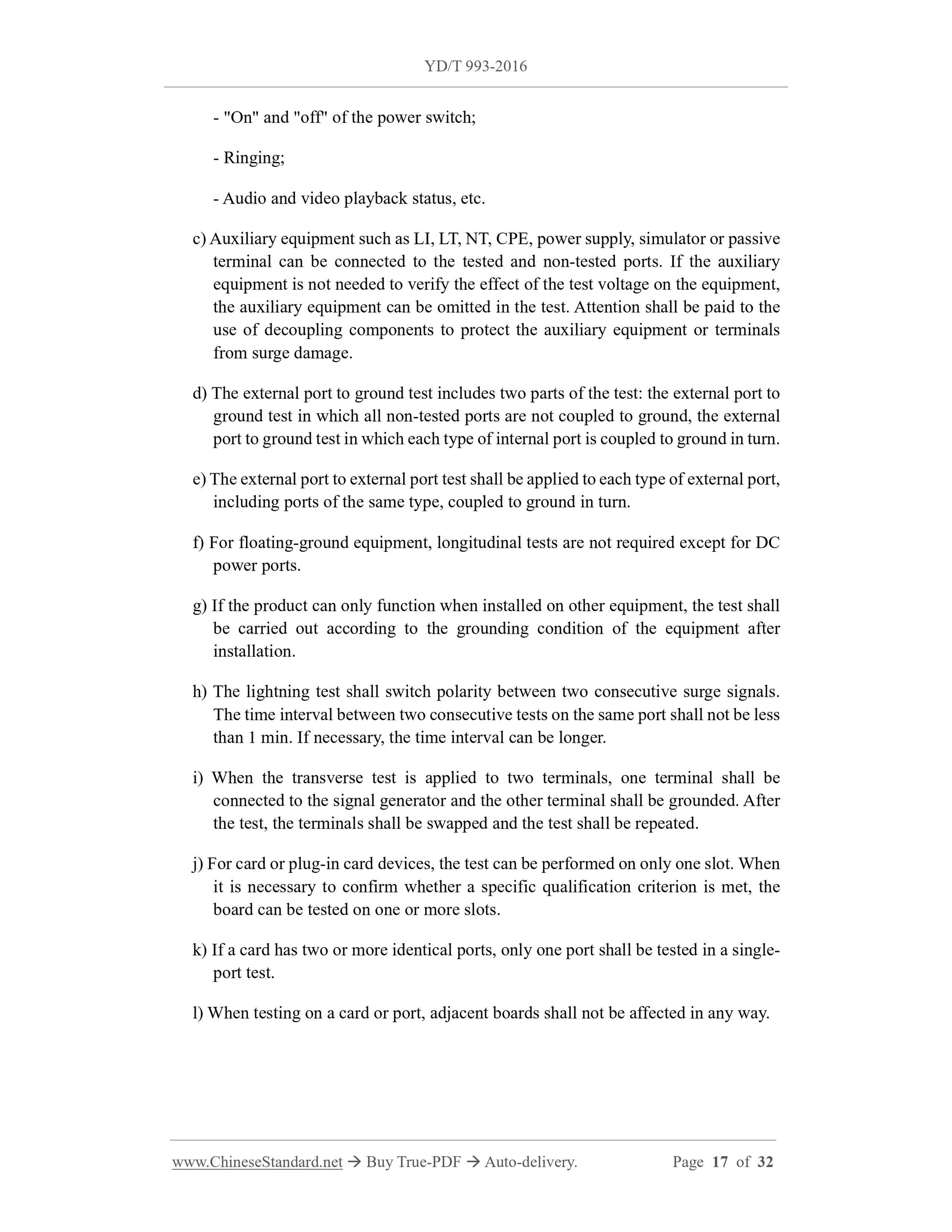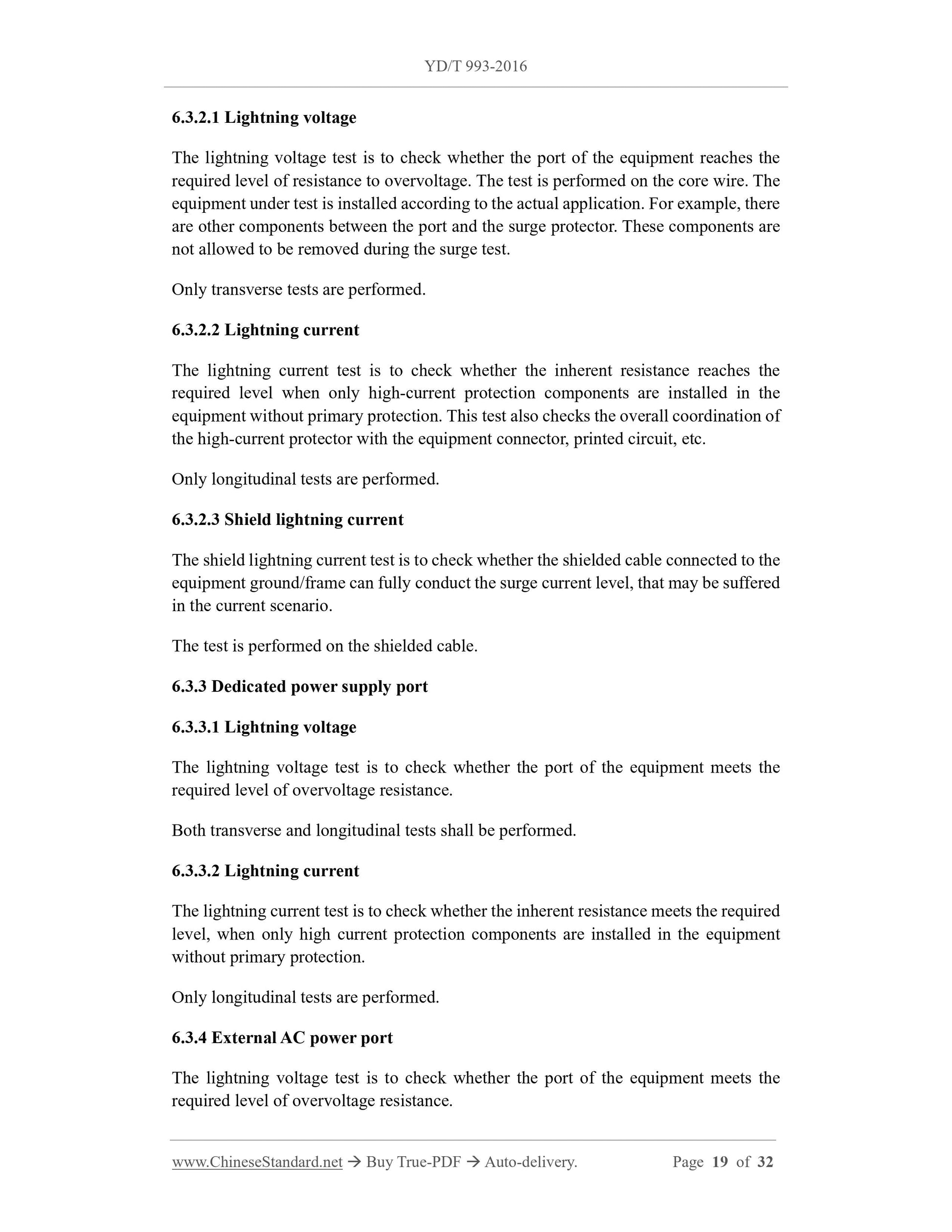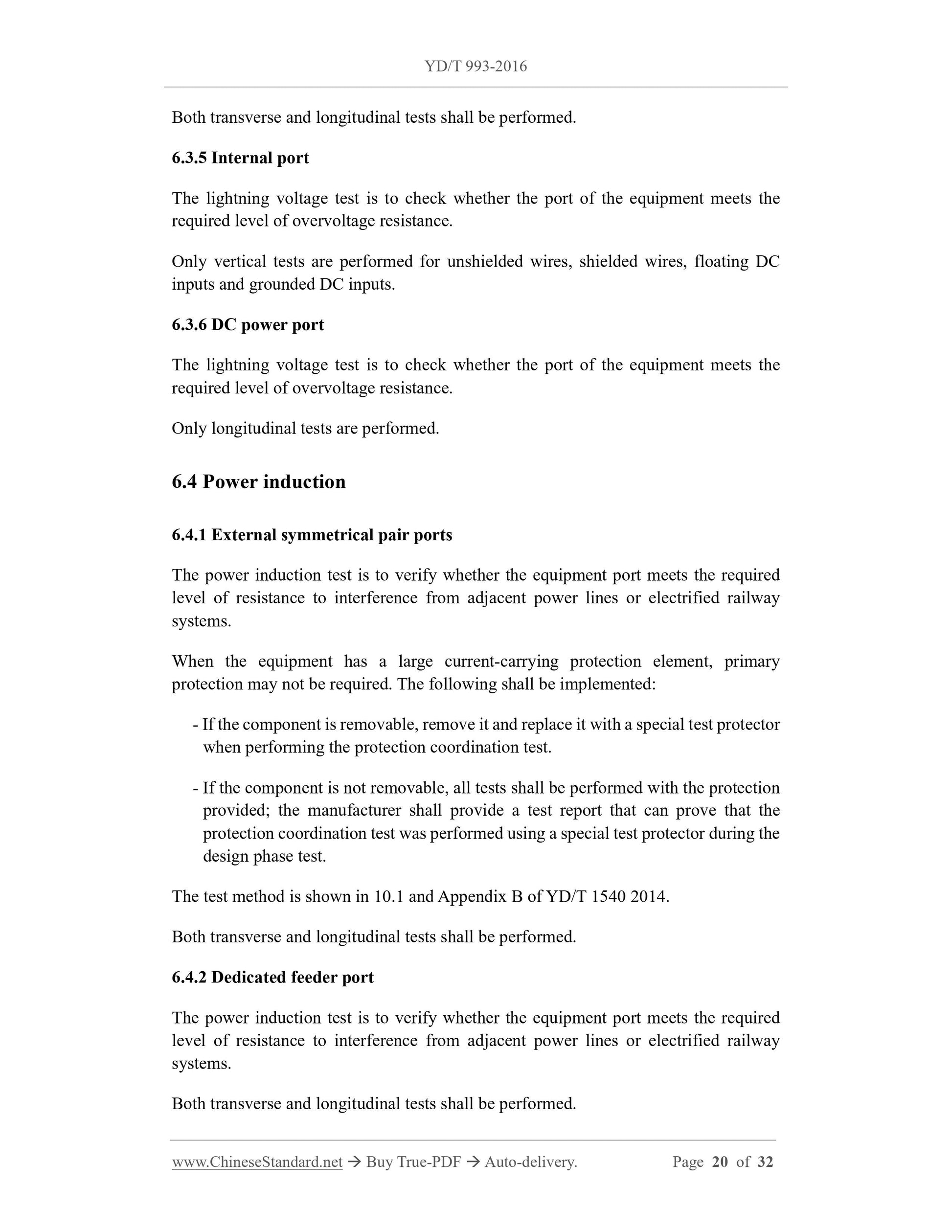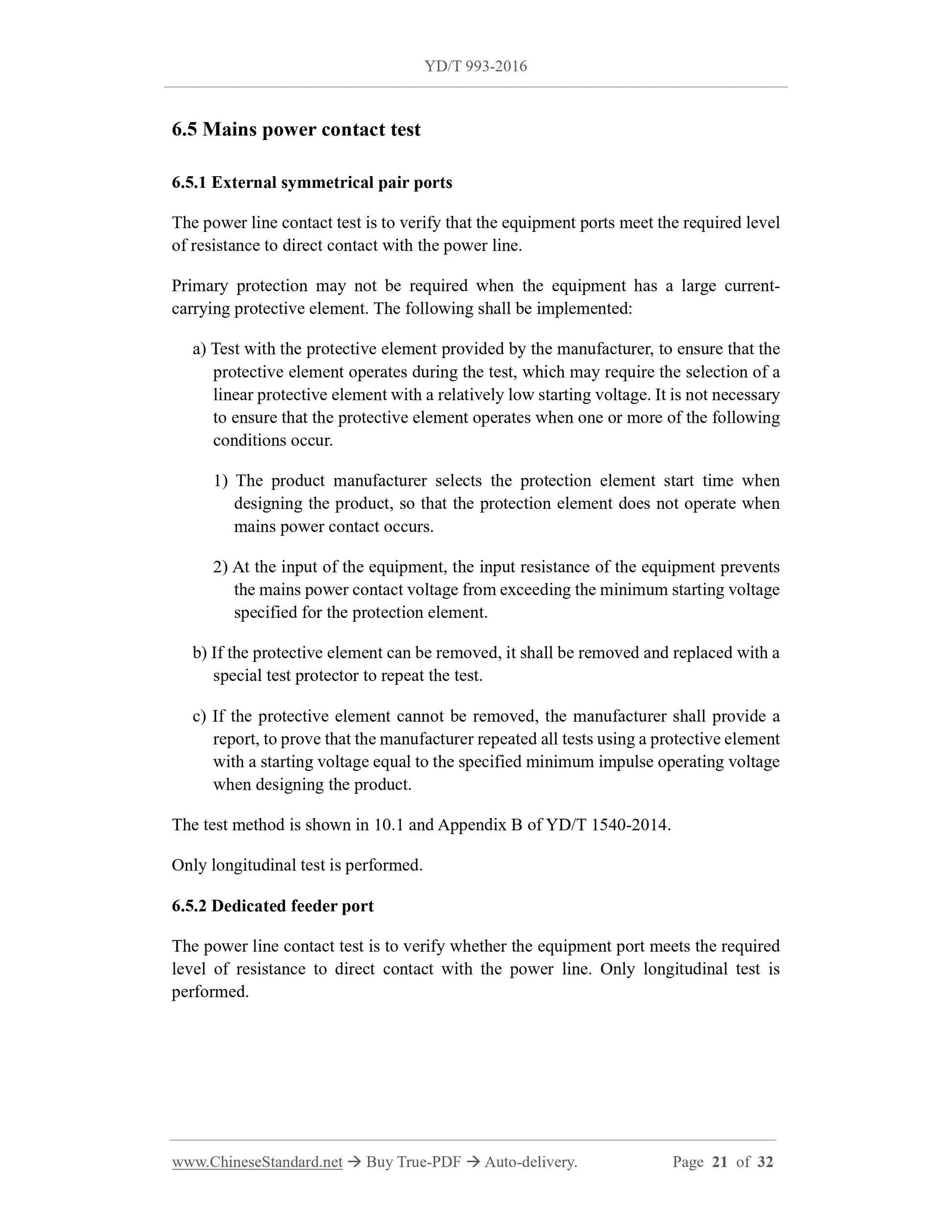1
/
of
8
PayPal, credit cards. Download editable-PDF and invoice in 1 second!
YD/T 993-2016 English PDF (YD/T993-2016)
YD/T 993-2016 English PDF (YD/T993-2016)
Regular price
$365.00 USD
Regular price
Sale price
$365.00 USD
Unit price
/
per
Shipping calculated at checkout.
Couldn't load pickup availability
Delivery: 3 seconds. Download true-PDF + Invoice.
Get QUOTATION in 1-minute: Click YD/T 993-2016
Historical versions: YD/T 993-2016
Preview True-PDF (Reload/Scroll if blank)
YD/T 993-2016: The technical requirements and test methods of overvoltages and overcurrents resistibility for wire telecommunication terminal equipment
YD/T 993-2016
YD
TELECOMMUNICATION INDUSTRY STANDARD
OF THE PEOPLE’S REPUBLIC OF CHINA
ICS 35.050.01
M40
Replacing YD/T 993-2006
The technical requirements and test methods of overvoltages
and overcurrents resistibility for wire telecommunication
terminal equipment
ISSUED ON: OCTOBER 22, 2016
IMPLEMENTED ON: JANUARY 01, 2017
Issued by: Ministry of Industry and Information Technology of PRC
Table of Contents
Foreword ... 3
1 Scope ... 4
2 Normative references ... 4
3 Terms, definitions, abbreviations ... 4
3.1 Terms and definitions ... 4
3.2 Abbreviations ... 7
4 Classification of product application environment ... 8
4.1 Category I Environment ... 8
4.2 Category II environment ... 9
4.3 Marking and description ... 9
5 Technical requirements ... 10
5.1 Test types ... 10
5.2 Protection coordination test ... 11
5.3 Technical requirements ... 11
6 Test methods ... 16
6.1 Test conditions ... 16
6.2 Recommended test procedure ... 18
6.3 Simulated lightning test ... 18
6.4 Power induction ... 20
6.5 Mains power contact test ... 21
Appendix A (Normative) Example of test circuit configuration ... 22
Appendix B (Normative) Qualification criteria ... 31
The technical requirements and test methods of overvoltages
and overcurrents resistibility for wire telecommunication
terminal equipment
1 Scope
This standard specifies the technical requirements and test methods for lightning
protection and safety protection of wired telecommunications terminal equipment.
This standard applies to the protection performance inspection of wired
telecommunications terminal products (including indoor and outdoor types), which are
connected to communication networks and public power grids.
2 Normative references
The following documents are essential to the application of this document. For the dated
documents, only the versions with the dates indicated are applicable to this document;
for the undated documents, only the latest version (including all the amendments) is
applicable to this standard.
GB/T 17626.5-2008 Electromagnetic compatibility - Testing and measurement
techniques - Surge immunity test
YD/T 1540-2014 Over-voltage and over-current telecommunications equipment
resistance test methods
3 Terms, definitions, abbreviations
3.1 Terms and definitions
The following terms and definitions apply to this document.
3.1.1
Telecommunication terminal equipment, TTE
Telecommunication equipment which is connected to the end of the public
telecommunication network, to provide users with the function of sending and
- "On" and "off" of the power switch;
- Ringing;
- Audio and video playback status, etc.
c) Auxiliary equipment such as LI, LT, NT, CPE, power supply, simulator or passive
terminal can be connected to the tested and non-tested ports. If the auxiliary
equipment is not needed to verify the effect of the test voltage on the equipment,
the auxiliary equipment can be omitted in the test. Attention shall be paid to the
use of decoupling components to protect the auxiliary equipment or terminals
from surge damage.
d) The external port to ground test includes two parts of the test: the external port to
ground test in which all non-tested ports are not coupled to ground, the external
port to ground test in which each type of internal port is coupled to ground in turn.
e) The external port to external port test shall be applied to each type of external port,
including ports of the same type, coupled to ground in turn.
f) For floating-ground equipment, longitudinal tests are not required except for DC
power ports.
g) If the product can only function when installed on other equipment, the test shall
be carried out according to the grounding condition of the equipment after
installation.
h) The lightning test shall switch polarity between two consecutive surge signals.
The time interval between two consecutive tests on the same port shall not be less
than 1 min. If necessary, the time interval can be longer.
i) When the transverse test is applied to two terminals, one terminal shall be
connected to the signal generator and the other terminal shall be grounded. After
the test, the terminals shall be swapped and the test shall be repeated.
j) For card or plug-in card devices, the test can be performed on only one slot. When
it is necessary to confirm whether a specific qualification criterion is met, the
board can be tested on one or more slots.
k) If a card has two or more identical ports, only one port shall be tested in a single-
port test.
l) When testing on a card or port, adjacent boards shall not be affected in any way.
6.3.2.1 Lightning voltage
The lightning voltage test is to check whether the port of the equipment reaches the
required level of resistance to overvoltage. The test is performed on the core wire. The
equipment under test is installed according to the actual application. For example, there
are other components between the port and the surge protector. These components are
not allowed to be removed during the surge test.
Only transverse tests are performed.
6.3.2.2 Lightning current
The lightning current test is to check whether the inherent resistance reaches the
required level when only high-current protection components are installed in the
equipment without primary protection. This test also checks the overall coordination of
the high-current protector with the equipment connector, printed circuit, etc.
Only longitudinal tests are performed.
6.3.2.3 Shield lightning current
The shield lightning current test is to check whether the shielded cable connected to the
equipment ground/frame can fully conduct the surge current level, that may be suffered
in the current scenario.
The test is performed on the shielded cable.
6.3.3 Dedicated power supply port
6.3.3.1 Lightning voltage
The lightning voltage test is to check whether the port of the equipment meets the
required level of overvoltage resistance.
Both transverse and longitudinal tests shall be performed.
6.3.3.2 Lightning current
The lightning current test is to check whether the inherent resistance meets the required
level, when only high current protection components are installed in the equipment
without primary protection.
Only longitudinal tests are performed.
6.3.4 External AC power port
The lightning voltage test is to check whether the port of the equipment meets the
required level of overvoltage resistance.
Both transverse and longitudinal tests shall be performed.
6.3.5 Internal port
The lightning voltage test is to check whether the port of the equipment meets the
required level of overvoltage resistance.
Only vertical tests are performed for unshielded wires, shielded wires, floating DC
inputs and grounded DC inputs.
6.3.6 DC power port
The lightning voltage test is to check whether the port of the equipment meets the
required level of overvoltage resistance.
Only longitudinal tests are performed.
6.4 Power induction
6.4.1 External symmetrical pair ports
The power induction test is to verify whether the equipment port meets the required
level of resistance to interference from adjacent power lines or electrified railway
systems.
When the equipment has a large current-carrying protection element, primary
protection may not be required. The following shall be implemented:
- If the component is removable, remove it and...
Get QUOTATION in 1-minute: Click YD/T 993-2016
Historical versions: YD/T 993-2016
Preview True-PDF (Reload/Scroll if blank)
YD/T 993-2016: The technical requirements and test methods of overvoltages and overcurrents resistibility for wire telecommunication terminal equipment
YD/T 993-2016
YD
TELECOMMUNICATION INDUSTRY STANDARD
OF THE PEOPLE’S REPUBLIC OF CHINA
ICS 35.050.01
M40
Replacing YD/T 993-2006
The technical requirements and test methods of overvoltages
and overcurrents resistibility for wire telecommunication
terminal equipment
ISSUED ON: OCTOBER 22, 2016
IMPLEMENTED ON: JANUARY 01, 2017
Issued by: Ministry of Industry and Information Technology of PRC
Table of Contents
Foreword ... 3
1 Scope ... 4
2 Normative references ... 4
3 Terms, definitions, abbreviations ... 4
3.1 Terms and definitions ... 4
3.2 Abbreviations ... 7
4 Classification of product application environment ... 8
4.1 Category I Environment ... 8
4.2 Category II environment ... 9
4.3 Marking and description ... 9
5 Technical requirements ... 10
5.1 Test types ... 10
5.2 Protection coordination test ... 11
5.3 Technical requirements ... 11
6 Test methods ... 16
6.1 Test conditions ... 16
6.2 Recommended test procedure ... 18
6.3 Simulated lightning test ... 18
6.4 Power induction ... 20
6.5 Mains power contact test ... 21
Appendix A (Normative) Example of test circuit configuration ... 22
Appendix B (Normative) Qualification criteria ... 31
The technical requirements and test methods of overvoltages
and overcurrents resistibility for wire telecommunication
terminal equipment
1 Scope
This standard specifies the technical requirements and test methods for lightning
protection and safety protection of wired telecommunications terminal equipment.
This standard applies to the protection performance inspection of wired
telecommunications terminal products (including indoor and outdoor types), which are
connected to communication networks and public power grids.
2 Normative references
The following documents are essential to the application of this document. For the dated
documents, only the versions with the dates indicated are applicable to this document;
for the undated documents, only the latest version (including all the amendments) is
applicable to this standard.
GB/T 17626.5-2008 Electromagnetic compatibility - Testing and measurement
techniques - Surge immunity test
YD/T 1540-2014 Over-voltage and over-current telecommunications equipment
resistance test methods
3 Terms, definitions, abbreviations
3.1 Terms and definitions
The following terms and definitions apply to this document.
3.1.1
Telecommunication terminal equipment, TTE
Telecommunication equipment which is connected to the end of the public
telecommunication network, to provide users with the function of sending and
- "On" and "off" of the power switch;
- Ringing;
- Audio and video playback status, etc.
c) Auxiliary equipment such as LI, LT, NT, CPE, power supply, simulator or passive
terminal can be connected to the tested and non-tested ports. If the auxiliary
equipment is not needed to verify the effect of the test voltage on the equipment,
the auxiliary equipment can be omitted in the test. Attention shall be paid to the
use of decoupling components to protect the auxiliary equipment or terminals
from surge damage.
d) The external port to ground test includes two parts of the test: the external port to
ground test in which all non-tested ports are not coupled to ground, the external
port to ground test in which each type of internal port is coupled to ground in turn.
e) The external port to external port test shall be applied to each type of external port,
including ports of the same type, coupled to ground in turn.
f) For floating-ground equipment, longitudinal tests are not required except for DC
power ports.
g) If the product can only function when installed on other equipment, the test shall
be carried out according to the grounding condition of the equipment after
installation.
h) The lightning test shall switch polarity between two consecutive surge signals.
The time interval between two consecutive tests on the same port shall not be less
than 1 min. If necessary, the time interval can be longer.
i) When the transverse test is applied to two terminals, one terminal shall be
connected to the signal generator and the other terminal shall be grounded. After
the test, the terminals shall be swapped and the test shall be repeated.
j) For card or plug-in card devices, the test can be performed on only one slot. When
it is necessary to confirm whether a specific qualification criterion is met, the
board can be tested on one or more slots.
k) If a card has two or more identical ports, only one port shall be tested in a single-
port test.
l) When testing on a card or port, adjacent boards shall not be affected in any way.
6.3.2.1 Lightning voltage
The lightning voltage test is to check whether the port of the equipment reaches the
required level of resistance to overvoltage. The test is performed on the core wire. The
equipment under test is installed according to the actual application. For example, there
are other components between the port and the surge protector. These components are
not allowed to be removed during the surge test.
Only transverse tests are performed.
6.3.2.2 Lightning current
The lightning current test is to check whether the inherent resistance reaches the
required level when only high-current protection components are installed in the
equipment without primary protection. This test also checks the overall coordination of
the high-current protector with the equipment connector, printed circuit, etc.
Only longitudinal tests are performed.
6.3.2.3 Shield lightning current
The shield lightning current test is to check whether the shielded cable connected to the
equipment ground/frame can fully conduct the surge current level, that may be suffered
in the current scenario.
The test is performed on the shielded cable.
6.3.3 Dedicated power supply port
6.3.3.1 Lightning voltage
The lightning voltage test is to check whether the port of the equipment meets the
required level of overvoltage resistance.
Both transverse and longitudinal tests shall be performed.
6.3.3.2 Lightning current
The lightning current test is to check whether the inherent resistance meets the required
level, when only high current protection components are installed in the equipment
without primary protection.
Only longitudinal tests are performed.
6.3.4 External AC power port
The lightning voltage test is to check whether the port of the equipment meets the
required level of overvoltage resistance.
Both transverse and longitudinal tests shall be performed.
6.3.5 Internal port
The lightning voltage test is to check whether the port of the equipment meets the
required level of overvoltage resistance.
Only vertical tests are performed for unshielded wires, shielded wires, floating DC
inputs and grounded DC inputs.
6.3.6 DC power port
The lightning voltage test is to check whether the port of the equipment meets the
required level of overvoltage resistance.
Only longitudinal tests are performed.
6.4 Power induction
6.4.1 External symmetrical pair ports
The power induction test is to verify whether the equipment port meets the required
level of resistance to interference from adjacent power lines or electrified railway
systems.
When the equipment has a large current-carrying protection element, primary
protection may not be required. The following shall be implemented:
- If the component is removable, remove it and...
Share
